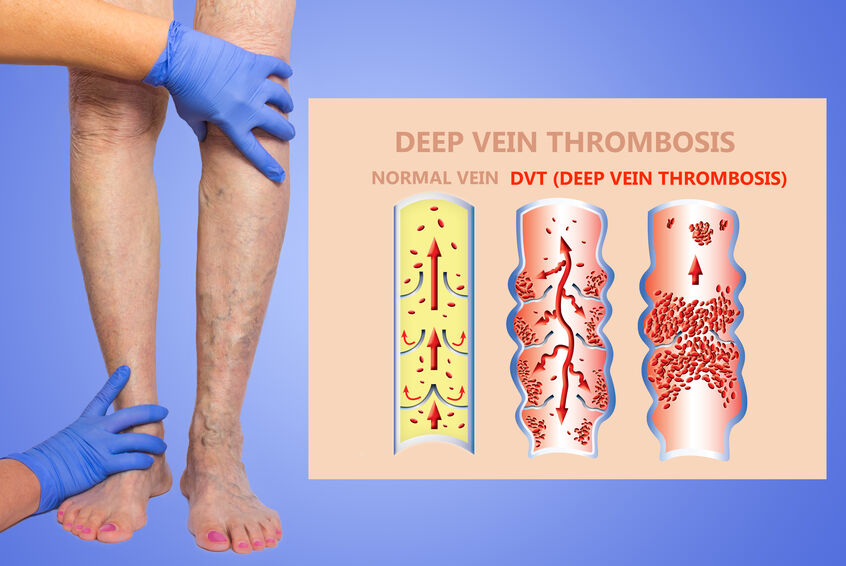
March is national Deep-Vein Thrombosis Awareness Month, a public health initiative aimed at raising awareness of this commonly occurring medical condition. According to the American Heart Association, up to 2 million Americans are affected annually by DVT, more commonly known as blood clots. Yet, most Americans have little or no awareness of DVT, according to a national survey sponsored by the American Public Health Association.
What is DVT?
Deep vein thrombosis (DVT) occurs when a blood clot (thrombus) forms in one or more of the deep veins in your body, usually in your legs. Deep vein thrombosis can cause leg pain or swelling but can also occur with no symptoms. These blood clots can be caused by lack of motion, damaged veins, or if you naturally have thicker blood, and often first occur in the thigh or lower leg. Some conditions can increase your risk of DVT, including smoking, pregnancy, recent surgery, being over sixty, and being overweight.
How to Treat DVT
One of the best ways to treat DVT on your own is to use compression hosiery to squeeze blood up the legs to prevent swelling and clots. Here are some of the many benefits compression legwear can provide you, especially if you suffer from DVT.
- Boosts circulation in your legs
- Supports veins
- Diminishes leg swelling
- Prevents blood from pooling in your legs
- Helps prevent venous ulcers
- Improves lymphatic drainage
- Lessens pain caused by varicose veins
- Prevents the development of DVT in your legs
Types of Compression Stockings
Compression stockings apply pressure to your legs and ankles, which helps blood flow towards the heart, reduces the diameter of major veins by increasing the volume and velocity of blood flow, and prevents blood from refluxing downward to the foot or laterally into superficial veins.
Anti-Embolism Stockings
Anti-embolism stockings reduce the possibility of DVT by providing gradient compression. They are more designed for those who are not mobile.
Graduated Compression Stockings
In graduated compression stockings, the compression level is strongest at the ankle and gradually decreases towards the top. They’re designed for mobility and meet certain length and medical strength specifications. Stockings that end below the knee help limit peripheral edema or lower leg swelling due to fluid buildup. Stockings that extend to the thigh or waist help reduce blood pooling in the legs and help prevent orthostatic hypotension.
Nonmedical Support Hosiery
Nonmedical support hosiery typically does not require a prescription. These options include elastic support hose and flight socks sold as a potential relief for tired, aching legs. This specific hosiery delivers uniform compression that exerts less pressure than prescription compression stockings.
Who Can Wear Compression Legwear?
You don’t need a doctor’s approval to give compression legwear a try, but you might get prescribed compression stockings to help you with a condition such as venous insufficiency. If you get prescribed medical-grade compression stockings, make sure to get fitted properly and follow your doctor’s instructions on how long to wear them and when. It’s also important to monitor any skin changes in the areas that come in contact with the stockings.
While compression socks may be most associated with older patients, they’re applicable for adults of any age. In fact, many athletes in various sports wear different variations of compression socks or even compression sleeves to help with performance and prevent injury.
Advice for New Wearers
If it’s your first time wearing compression socks, don’t be afraid to take them off and make adjustments to them, as they may be uncomfortable at first. Also, take into consideration the difference between below or above-knee socks. If you have thicker calf muscles, it would be wise to get above-knee compression socks. Sometimes that extra few inches of material can create more comfort at the top of your calf, so it’s not extra tight on your skin.
It is important to remember that compression socks are just one part of your regiment in helping ease the discomfort of DVT and other blood clotting disorders. Make sure you’re drinking plenty of water, consuming a low-salt diet, and moving your legs often!
At BEK Medical, we understand how challenging it can be to find the perfect products to make your day-to-day life easier and more productive. That is why we stock our stores with the highest-quality medical equipment. We offer various compression legwear products, including Velcro options!
Check out our online shop or give us a call to speak with a medical equipment expert who can guide you in the right direction to the products that will best give you the comfort and relief you deserve!
